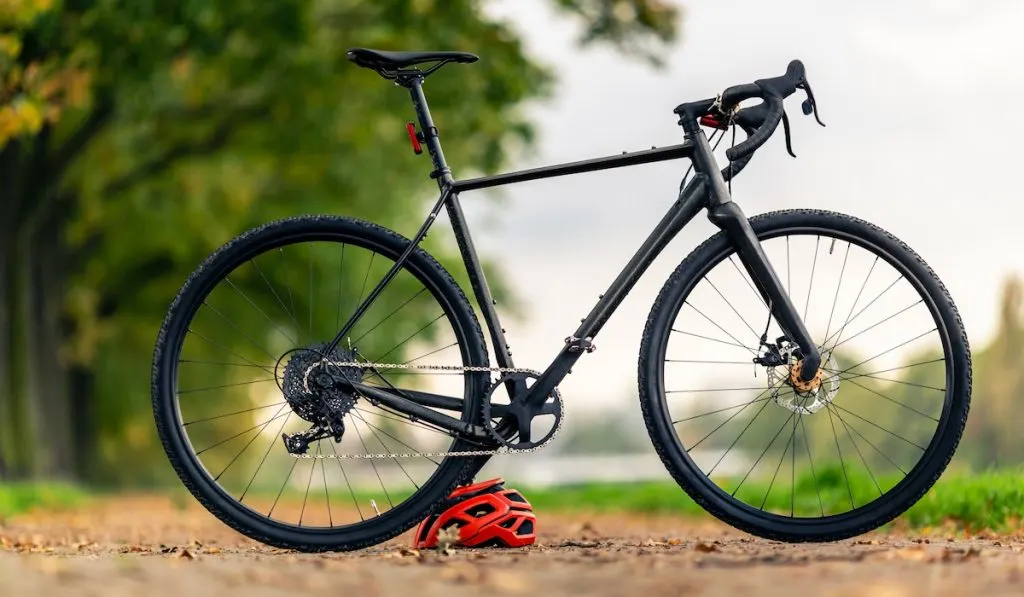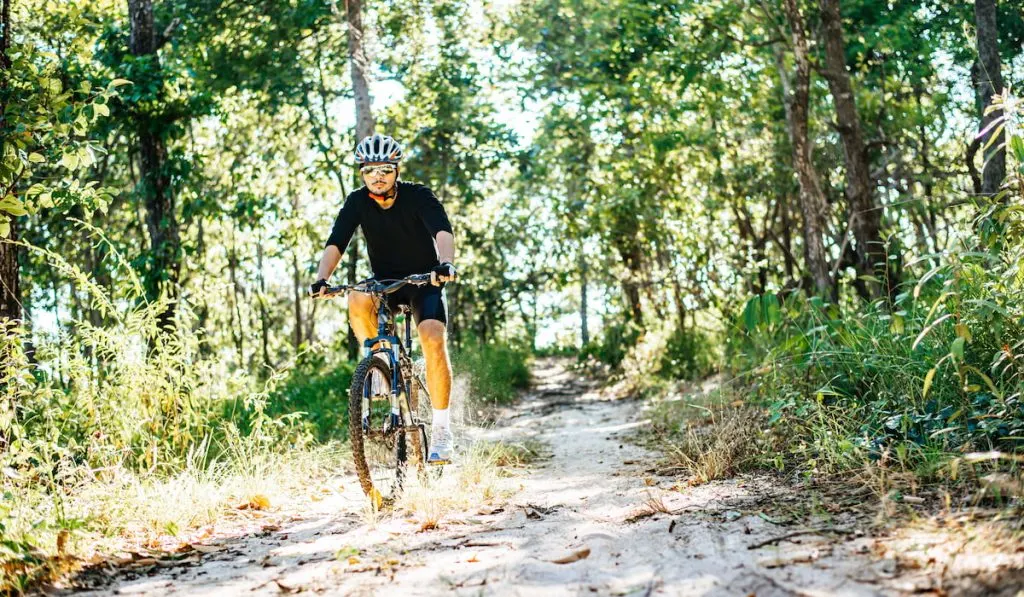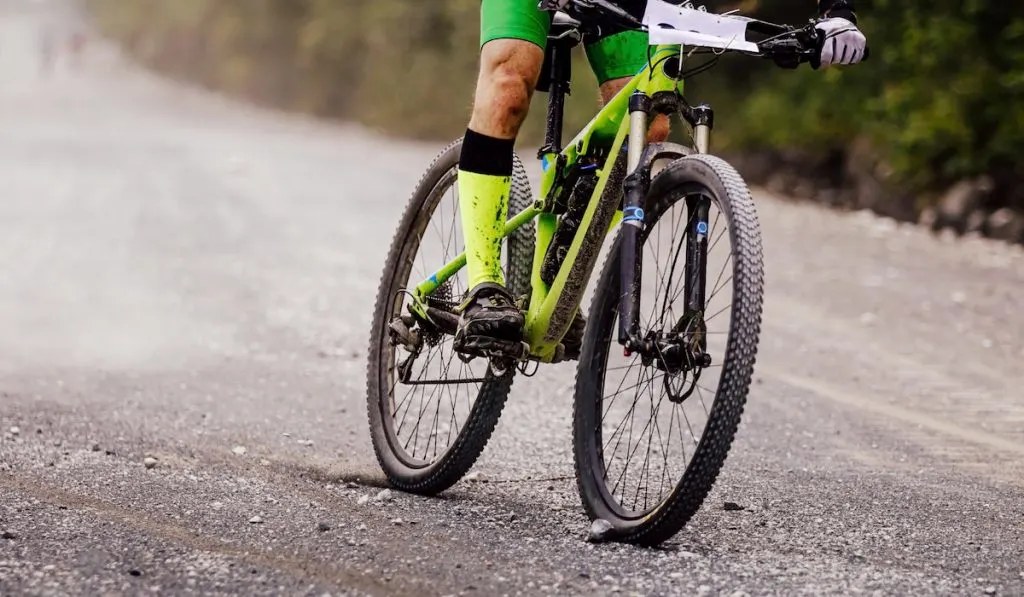If you are planning to take part in a gravel race or simply want to ride a local gravel trail but own a road bike, don’t worry!
You do not need to buy a gravel-specific bike for that type of terrain.
Whether you own a mountain bike, a hybrid, cyclo-cross, or a road bike, it is possible to ride it on gravel. Keep reading this article to find out how.
Let’s first take a look at the difference between a gravel bike and a road bike.

Road Bike vs. Gravel Bike
As the name explains, road bikes are the bicycles that you can ride on tarmac bias, whereas gravel bikes can be taken off-road on paths such as gravel, fire trails, single track, and dirt roads.
Road bikes usually come in two types: race bikes and endurance bikes.
Race bikes are used mainly by professionals. They have aggressive angles, are low weight, and built to minimize aerodynamic drag.
Endurance bikes are slightly more upright, more comfortable, and have more stable handling than race bikes.
To ride on loose gravel, greater stability is required. This is why endurance road bikes are preferred for that.
Though you can ride any bike on gravel, some modifications to your road bike will make your experience better.
Tips for Modifying Your Bike
Tires
Tires are a vital part of a bike, so you must modify them first. The type of tires you should use mainly depend on the type of gravel you will be riding on.
Larger and wider tires are better suited for gravel as they allow greater traction and let you use a lower level of pressure, minimizing the risk of a puncture.
Ideally, try to use tires with a width of 25mm (.98 inches).
Chain
Riding on gravel means riding on rough surfaces. Rough surfaces will slow down your average speed.
Therefore, wide front chainrings and smaller rear cassette cogs, which are prevalent on road bikes, may not be the ideal option.
Using compact front chainrings and a larger rear cassette will offer more options when riding at a slower speed.
This will also prevent you from being exhausted quickly, which is important if you plan to participate in a gravel race or training ride that is longer than 30 miles.
Saddle
On gravel, you will need to keep your body in an upright position. Sitting in this position can cause discomfort or numbness as it puts pressure on your body other than the sit bones.
It is better to use a saddle with a bit more cushion to avoid facing such issues.

Bar Tape
As road bikes usually don’t come with a front shock, this means your body will have to absorb the effects of bouncing when riding on rough terrain.
Using thick bar tape will make things easier for your hands and arms by absorbing some of the vibrations.
Brakes
Using a bike with disc brakes may be a better option than using one with rim brakes, especially if the weather is expected to be rainy and the path is going to be muddy.
Mud will clog your rim brakes, preventing your wheels from spinning, making it impossible for you to ride.
Even after modifying your bike, you may experience some difficulty in riding smoothly on gravel if you don’t alter your riding style. Mentioned below are some riding tips that can help you.
Tips for Riding Your Bike on Gravel
Be Relaxed
Gravel roads may be immaculately smooth or strewn with rocks, pits, and washboards.
Rough terrains can put a strain on your body and deplete your energy. Therefore, it is important to loosen up and be relaxed. This way, your body will be able to absorb the bumps.
While riding gravel, the secret is to remain smooth. Avoid making violent body movements or making massive, rapid weight transfers. Allow the motion of your wheels to perform its magic.
Remain Seated
On a road bike, whether to stand up or remain seated is largely a matter of personal preference. However, standing up is a lot riskier when the road turns to gravel.
Stay seated to hold the majority of your weight over your back wheel as much as possible to retain traction. This will improve your bike’s handling and prevent your wheels from spinning on loose roads.
Choose Lines Carefully
It is essential to read the road surface ahead and scan areas that may be broken. Try to be on smooth lines that are free of rocks and allow comfortable, easy traction.
Riding on smoother and harder roads is preferable. However, if you do end up in soft mud or snow, try to keep your bike straight and upright.
Be Cautious While Cornering and Descending
Many new riders struggle to properly corner and descend their bikes on loose gravel.
Begin by lowering your center of gravity. You can do this by keeping your chest low and dropping your heels.
When cornering, lean the bike underneath you. Leaning will allow the bike to turn, and leaning separately from your body distributes more weight over the contact patch of the tire, increasing traction and control.
It is preferable to descend in drops because it keeps you low and provides you more control over rugged terrain. Riding in the drops gives you a better grip and more leverage when it comes to pulling the brake levers.
Avoid riding on the hoods as hoods are more difficult to hold solidly, and braking hard from the hoods is very challenging.

Brake Smoothly
When you are riding on loose surfaces, apply the brakes smoothly, so you don’t end up locking them. The traction of a skidding tire is significantly less than that of a rolling tire.
Greater stopping power lies in the front brakes, therefore, they should be modulated carefully in accordance with the rear brake.
Now that you know all the tips and tricks to modify your bike and ride on gravel, take your bike and go on that ride without any worry!
